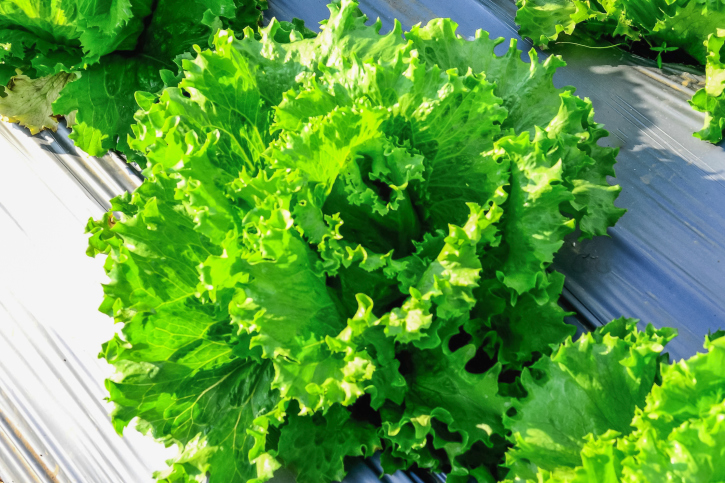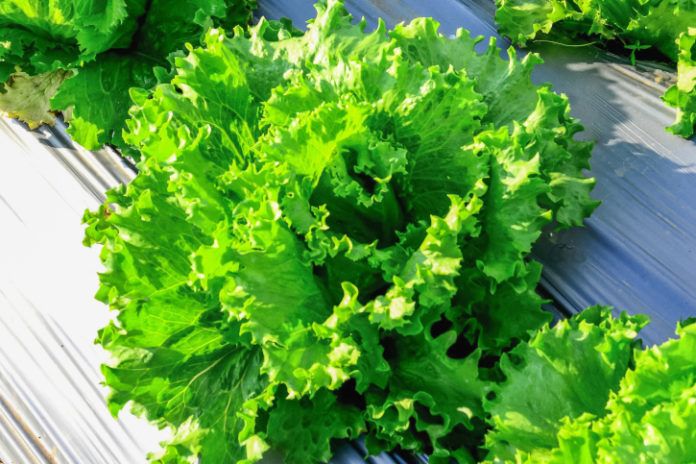Break out of the iceberg box and discover nutritious lettuces and other healthy greens.

If not for lettuce and salads, many Americans would hardly eat any green vegetables at all. Lettuce ranks behind only potatoes and tomatoes (technically a fruit) among the most popular vegetables. A nice, big salad can go a long way toward the two to three cups (depending on your age and gender) of daily vegetables recommended by the federal governments MyPlate <myplate.gov>, though you should count every two cups of raw, leafy greens as one cup toward that goal.
As a reader of this newsletter, you already know to be careful about offsetting all the nutritional benefits of a salad by piling on creamy dressings high in saturated fat and calories-not to mention chunks of cheese, salty croutons and bacon bits. Plain lettuce, after all, contains only about 14 calories in two cups. But you can easily turn a healthy salad into a plate thats no better for you than a burger and fries. (When eating out, keep in mind that those healthy-sounding salads are not necessarily the wisest choice on the menu because of fatty dressings and caloric toppings.)
| Basic Vinaigrette |
Save on calories, saturated fat and grocery costs by whipping up your own dressing.
- 2 Tbsp vinegar
- 1/2 to 1 tsp Dijon-style mustard
- 1/4 tsp kosher salt
- 1/4 tsp freshly ground black pepper
- 6 Tbsp extra-virgin olive oil (or other vegetable oil)
Whisk together vinegar, mustard and salt and pepper. Add the oil in a stream, whisking, and continue to whisk until vinaigrette is emulsified.
Vary your vinaigrette by adding finely chopped shallots (up to 2 Tbsp)or fresh herbs, or by trying various types of vinegar. The smart way to approach a salad bar is to do a quick scan and then make a plan, says Alice H. Lichtenstein, DSc, director of Tufts HNRCA Cardiovascular Nutrition Laboratory. First pile on the leafy greens, then the other vegetable and fruit toppings-for example, shredded carrots, raw broccoli, pieces of fruit (if available). These salad items should cover most of the plate or bowl. After that you need to ask yourself, what else do I really want and what am I willing to forgo? For example, if you really want a little bit of the creamy dressing, thats fine, but you need to pass up the cheese. If you really want the cheese, then you are going to need to go lightly on the dressing, perhaps with a bit of oil and vinegar or lemon juice. As far as the bacon and croutons, my recommendation is to ignore them, because of extra calories, saturated fat and salt
At home, a bowl of greens simply dressed in a homemade vinaigrette (see box) will save you money compared to buying pricey bottled dressings, while adding relatively little salt and giving you heart-healthy unsaturated fats. For toppings, try sprinkling a few nuts-not too many, as theyre calorie-dense (see our May 2012 Special Supplement)-and definitely slices of other veggies or fruit. Get creative with colors and shapes!
A little creativity can also boost the nutritional value of the lettuce and other greens you build your salads with. Unfortunately, Americans favorite choice of salad green-iceberg lettuce-is by far the least nutrient- dense option in that whole grocery aisle. Thinking outside the iceberg-lettuce box can substantially boost the health benefits of salads. Deeply colored greens contain vitamins A, C and K, beta-carotene and other carotenoids like lutein and zeaxanthin, calcium, folate and of course fiber. Green and red leaf lettuce, for example, contain nearly 15 times as much vitamin A as iceberg lettuce, 6 times the vitamin K, almost 20 times the beta-carotene and 6 times the lutein and zeaxanthin. Other popular varieties, such as Romaine, Bibb and Boston lettuce, outshine iceberg almost as much and exceed leaf lettuce in some nutrients. Broadening your selection even further and including greens such as spinach, radicchio and arugula can turn your salads into nutritional stars.
Greens other than iceberg also score higher in measures of phytonutrients, which can act as antioxidants and may combat inflammation and chronic diseases. Among popular lettuce varieties, red leaf packs the greatest phytonutrient punch, followed by green leaf and Romaine, butterhead (includes Bibb and Boston) and finally iceberg.
The pale color of iceberg lettuce should be your tipoff that its not all it could be, nutrition-wise. Lettuce and other greens are good for you because they contain the energy-converting machinery and protective pigments of plants. So, in general, the greener and more colorful, the better.
But dont worry too much about milligrams of this nutrient or micrograms of that in your salad bowl. Variety really is the spice of salads, and also hedges your bets nutritionally. A good formula for building a salad is to toss together at least three different kinds of greens:
- Start with a milder lettuce like butterhead, red leaf or green leaf.
- Toss in a crisp choice such as Romaine or cabbage-any type.
- Finish with flavorful, peppery or bitter greens like arugula or radicchio, or a milder but hearty pick like spinach.
Greens other than iceberg give a visual boost to your salads, says Lichtenstein, with different shades of greens and reds. Mixing and matching can be fun.
Building a smarter salad also means knowing what youre looking for in the produce aisle. If your greens routine has mostly been limited to iceberg lettuce and maybe the occasional Romaine or Bibb fling, heres a crash course on the options for your next salad and what they bring to the table-in taste and texture as well as nutrition.
Arugula-Also known as rocket, arugula is dark green and tender. Part of the mustard family, it has a distinctive peppery taste and is a good source of vitamins A, C and K, folate, calcium, potassium, magnesium and iron.
Butterhead-A type of lettuce that includes Bibb and Boston, butterhead is sweet, mild and tender, with rounded leaves that form a soft head; its often sold in a protective clamshell. Though not quite as high in most nutrients as leaf lettuce or Romaine, it nonetheless contains more than six times the vitamin A and other carotenoids and five times the vitamin K of iceberg lettuce. It beats leaf lettuce in potassium and folic acid.
Cress-In US supermarkets, youre most likely to find watercress, but other types include curly, upland and land cress. The stem is tough and fibrous, with small green leaves that have a bitter, peppery taste. Cress is especially high in vitamin K.
Endive-Also known as Belgian endive and witloof chicory, this unusual- looking salad ingredient comes in oval heads that separate into scooplike leaves that are pale yellow because the plants are grown under cover. Endive is smoothly crunchy and slightly bitter; the paler the color, the milder the flavor. Its a good source of folic acid, vitamins A and K and manganese, and is higher in potassium than lettuce.
Escarole-The frilly leaves of escarole-a broad-leafed variety of endive-range from light to dark green; its bitter quality increases with the coloring. The dark color is also a clue that escarole is packed with nutrients (similar to spinach and kale), notably vitamins A, C and K and folic acid.
Frise-This is the curly version of endive, with frilly, yellowish-green leaves (the color varies depending on how much, like regular endive, the developing plant is shielded from the light) and typically a more bitter taste. Frise adds variety and texture to salads; its often sold as part of mixed greens. Its nutritionally similar to endive.
Safe Salad Handling & Storing
|
Leaf lettuce-These large, ruffled leaves have a mild flavor and can be either all green or highlighted with red. Theres little nutritional difference between green and red leaf lettuce-both clobber iceberg on almost every count. Red leaf is slightly higher in vitamin C, while green leaf has more vitamin K.
Mche-Also sold as lambs lettuce, field lettuce or corn salad, this unusual, nutty-tasting greens delicate leaves belie its nutritional might. Its richer than ordinary lettuces in iron, potassium, vitamin C and folic acid and is a natural source of the plant form of omega-3 fatty acids.
Mesclun-Not a true lettuce variety, mesclun is simply French for a mix of tender young greens-typically chervil, arugula, leaf lettuce and endive. Since baby greens tend to be more concentrated in nutrition while also milder in flavor, mesclun makes an easy way to buy a variety of healthy salad fixings.
Mizuna-A Japanese mustard green sometimes included in salad mixes, mizuna has a more pungent flavor than other greens; you can recognize it by its smallish, jagged, oak-like leaves. Its high in folic acid, vitamin A and other carotenoids and vitamin C. As with other members of the mustard family, its related to broccoli and like that veggie contains sulfur compounds called glucosinolates that are being researched for anti-cancer properties.
Oakleaf-A looseleaf lettuce whose large leaves have an oak-like shape, oakleaf comes in green and reddish varieties and is easily mistaken for green or red leaf lettuce. Its a bit more delicate, with a softer texture at the top of the leaf, and is actually a type of butterhead lettuce. Its rich in minerals and vitamins A, B, C and E.
Radicchio-Another member of the chicory family (and also called red or Italian chicory), radicchio stands out in your salad bowl for its red-to-purple color. The bitter taste turns sweeter when cooked. Its a good source of vitamin C and potassium.
Romaine-Most familiar from Caesar salads, this large, leafy lettuce can add crunch to any type of salad (though you can remove the crunchy center rib if you prefer less bitterness). Romaine represents a big improvement on iceberg in lettuce nutrition, with more of pretty much everything you want in a healthy salad. It tops all lettuces in lutein and zeaxanthin, which promote eye health.
Spinach-Besides the canned and cooked spinach familiar from Popeye cartoons, raw spinach makes a hearty, slightly bitter salad staple. Baby spinach is more tender and blends more readily into mixed salads. Popeye was right about spinach nutrition, as its among the healthiest vegetables of any type. Two cups of raw spinach deliver more than 25% of your daily value for vitamins A, C and K, folate and manganese.
Tatsoi-Also called spoon cabbage and rosette bok choy, tatsoi resembles baby spinach and has a mild, mustardlike taste. Nutrients include vitamin C, potassium and calcium.
Weve barely begun to explore the greens galaxy, of course. Dont forget about cabbage, which is related to broccoli and cauliflower and shares their nutritional pluses. Some greens are more often eaten cooked than raw in salads, such as chard and kale. Depending on the season, your supermarket may even stock dandelion greens and purslane, which you can transform from weeds to gourmet salad fare. (If you collect them yourself, pick young plants that havent been exposed to pesticides or herbicides.)
Even poor old iceberg lettuce can have an occasional place in your salads, for low-calorie crunch-especially if you toss it with its more-nutritious cousins.
























